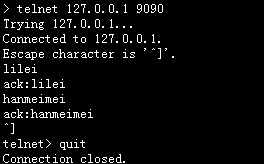Reference: http://www.cnblogs.com/mumuxinfei/p/4528910.html
前言:
最近帮朋友review其模块服务代码, 使用的是python的twisted网络框架. 鉴于之前并没有使用过, 于是决定好好研究一番.
twisted的reactor模型很好的处理了网络IO事件, 以及定时任务触发. 但包处理后的业务逻辑操作, 需要根据具体的场景来决定.
本文将讲述twisted如何实现half-sync/half-async的模式, 其线程池和defer模式是如何设计和使用的.
场景构造:
twisted服务接受业务请求, 后端需要访问mysql. 由于mysql的接口是同步的, 如果安装twisted默认的方式处理话, 其业务操作(mysql)会阻塞reactor的IO事件循环. 这大大降低了twisted的服务能力.
为了解决该类问题, twisted支持线程池. 把业务逻辑和IO事件分离, IO操作依旧是异步的, 而业务逻辑则采用线程池来处理.

工作线程池:
在具体讲述defer模式之前, 先谈谈reactor自带的线程池, 这也符合使用half-sync/half-async模式的直观理解.
先来构造下一个基础样例代码:
|
1
2
3
4
5
6
7
8
9
10
11
12
13
14
15
16
17
18
19
20
21
22
23
24
25
26
27
28
29
30
31
32
33
34
35
|
#! /usr/bin/python#-*- coding: UTF-8 -*-from twisted.internet import reactorfrom twisted.internet import protocolfrom twisted.protocols.basic import LineReceiverimport timeclass DemoProtocol(LineReceiver): def lineReceived(self, line): # 进行数据包的处理 reactor.callInThread(self.handle_request, line) def handle_request(self, line): """ hanlde_request: 进行具体的业务逻辑处理 """ # 边使用sleep(1)来代替模拟 time.sleep(1) # 借助callFromThread响应结果 reactor.callFromThread(self.write_response, line) def write_response(self, result): self.transport.write("ack:" + str(result) + "
")class DemoProtocolFactory(protocol.Factory): def buildProtocol(self, addr): return DemoProtocol() reactor.listenTCP(9090, DemoProtocolFactory())reactor.run() |
DemoProtocol在收到一行消息, 需要处理一个业务需耗时一秒, 于是其调用callInThread来借助reactor的线程池来执行.
其callInThread的函数定义如下:
|
1
2
|
def callInThread(self, _callable, *args, **kwargs): self.getThreadPool().callInThread(_callable, *args, **kwargs) |
从中, 我们可以印证之前的观点, 借助线程池来完成耗时阻塞的业务工作.
再来看一下callFromThread的函数定义:
|
1
2
3
4
|
def callFromThread(self, f, *args, **kw): assert callable(f), "%s is not callable" % (f,) self.threadCallQueue.append((f, args, kw)) self.wakeUp() |
其作用是把回调放入主线程(也是reactor主事件循环)的待执行队列中, 并及时唤醒reactor.
我们把写入响应的操作放入主循环中, 是为了让IO集中在主循环中进行, 避免潜在的线程不安全的问题.
defer模式:
直接使用reactor的线程池, 非常容易实现half-sync/half-async的模式, 也让IO和业务逻辑隔离. 但reactor设计之初, 更倾向于隐藏其内部的线程池. 于是其引入了defer模式.
让我们实现与上等同的代码片段:
|
1
2
3
4
5
6
7
8
9
10
11
12
13
14
15
16
17
18
19
20
21
22
23
24
25
26
27
28
29
30
31
32
33
34
35
36
|
#! /usr/bin/python#-*- coding: UTF-8 -*-from twisted.internet import reactorfrom twisted.internet import protocolfrom twisted.protocols.basic import LineReceiverfrom twisted.internet.threads import deferToThreadimport timeclass DemoProtocol(LineReceiver): def lineReceived(self, line): # 进行数据包的处理 deferToThread(self.handle_request, line).addCallback(self.write_response) def handle_request(self, line): """ hanlde_request: 进行具体的业务逻辑处理 """ # 边使用sleep(1)来代替模拟 time.sleep(1) return line def write_response(self, result): self.transport.write("ack:" + str(result) + "
") class DemoProtocolFactory(protocol.Factory): def buildProtocol(self, addr): return DemoProtocol() reactor.listenTCP(9090, DemoProtocolFactory())reactor.run() |
使用defer后, 代码更加的简洁. 其defer对象, 其实借用了线程池.
threads.deferToThread定义如下:
|
1
2
3
4
5
6
7
8
9
10
11
12
13
14
15
16
17
|
def deferToThread(f, *args, **kwargs): from twisted.internet import reactor return deferToThreadPool(reactor, reactor.getThreadPool(), f, *args, **kwargs)def deferToThreadPool(reactor, threadpool, f, *args, **kwargs): d = defer.Deferred() def onResult(success, result): if success: reactor.callFromThread(d.callback, result) else: reactor.callFromThread(d.errback, result) threadpool.callInThreadWithCallback(onResult, f, *args, **kwargs) return d |
这边我们可以发现deferToThread, 就是间接调用了callInThread函数, 另一方面, 对其回调函数的执行结果, 进行了onCallback, 以及onErrback的调用. 这些回调函数在主线程中运行.
defer模式简化了程序编写, 也改变了人们开发的思维模式.
测试回顾:
使用telnet进行测试, 结果正常.

另一方面, twisted的线程池, 其默认是采用延迟初始化的方式.
服务开启时, 只有主线程一个, 随着请求的到来, 其按需产生更多的worker thread.
而其线程池默认为10. 我们可以借助suggestThreadPoolSize方法来修改.